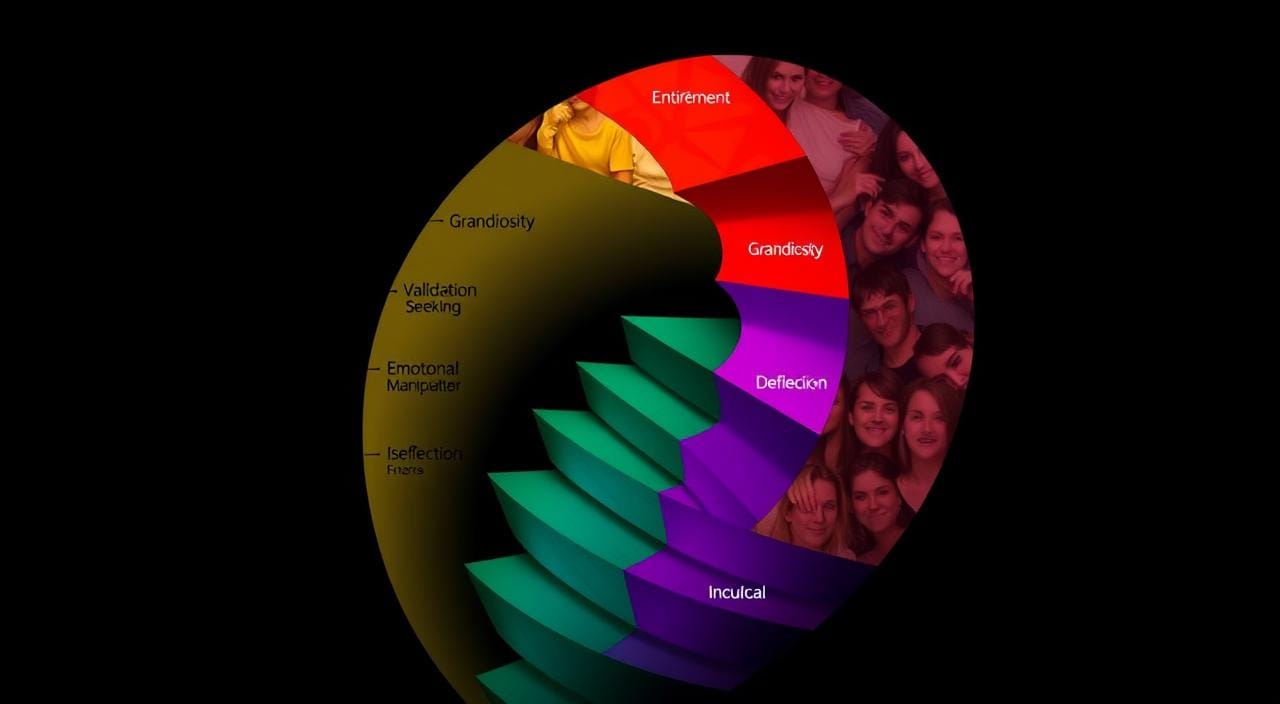Gaslighting is a harmful form of emotional abuse that can badly affect our mental health. It’s a tactic used by narcissists and in toxic relationships to distort our view of reality1. Research shows that feeling lonely and having weak social connections can shorten our lives as much as smoking 15 cigarettes a day1. Knowing the four main types of gaslighting is key to spotting and fighting this psychological attack.
Let’s jump into what are the 4 types of gaslighting?
Key Takeaways
- Gaslighting is a form of emotional abuse that manipulates the victim’s reality and perception.
- Narcissists and toxic relationships often employ gaslighting tactics.
- The four main types of gaslighting are countering, withholding, trivializing, and diverting.
- Recognizing the warning signs of gaslighting is crucial for protecting one’s mental health.
- Addressing and recovering from gaslighting requires setting boundaries, rebuilding self-trust, and seeking support.
What is Gaslighting?
Gaslighting comes from a 1938 play and its 1944 film, where a husband makes his wife doubt her sanity2. It’s when someone makes you doubt your own thoughts, memories, and feelings. Gaslighting is a kind of emotional abuse that can really hurt your mental health.
Definition and origins of the term
The term “gaslighting” comes from a play and film where a husband tries to make his wife think she’s losing her mind2. He does this by changing the gas lights and then saying he didn’t. This tactic is now known as a common way to emotionally abuse someone.
Gaslighting as a form of emotional abuse
Gaslighting is a form of emotional abuse because it makes you doubt yourself2. The abuser denies your reality, making you question your sanity. This gives them power over you. It can cause serious mental health issues like anxiety, depression, and PTSD.
| Key Aspects of Gaslighting | Description |
|---|---|
| Denying the victim’s reality | The perpetrator repeatedly denies the victim’s perceptions, memories, and experiences, making them question their own sanity. |
| Questioning the victim’s memory | The perpetrator may claim the victim is “remembering things wrong” or “imagining things” to discredit their recollection of events. |
| Emotional manipulation | The perpetrator uses emotional tactics, such as belittling, gaslighting, or withholding, to maintain control and power over the victim. |
| Isolation and dependency | The perpetrator may isolate the victim from friends, family, and support systems, making them more dependent on the abuser. |
“Gaslighting is a form of psychological manipulation in which the perpetrator makes the victim question their own reality, memory, or perceptions.”
Recognizing the Warning Signs
Gaslighting is a manipulative tactic that can deeply affect its victims. Understanding gaslighting tactics and spotting warning signs helps protect us and our loved ones. This way, we can fight against emotional abuse.
Common Gaslighting Tactics
- Denying facts or events that clearly occurred
- Shifting blame and responsibility onto the victim
- Minimizing or trivializing the victim’s experiences and emotions
- Questioning the victim’s memory, perception, and judgment
- Withholding information or refusing to engage in discussions
- Changing the subject to divert attention from the issue at hand
These tactics aim to make victims doubt their reality. This can lead to confusion, anxiety, and a loss of self-confidence. The psychological effects of gaslighting are severe, causing low self-esteem, depression, and isolation.
“Gaslighting is a form of psychological manipulation in which a person or a group covertly sows seeds of doubt in a targeted individual or group, making them question their own memory, perception, or judgment.” – Clinical psychologist Dr. Ariel Stern
Spotting these gaslighting warning signs and tackling the root issues helps victims regain their self-worth. It’s crucial to remember that the abuse’s blame falls on the gaslighter, not the victim3. This knowledge empowers victims to start healing and recovering4.
Type 1: Countering
Countering is a sneaky form of gaslighting. The person doing it denies what the victim says and doubts their memory and how they see things. Their goal is to make the victim question their own experiences, making them think their version of events is wrong or unreliable5.
Denying the Victim’s Reality
Countering gaslighting means the abuser flatly denies what the victim says, even when there’s clear proof. They might ignore the victim’s worries, say their feelings are wrong, or claim their view of things is wrong. This makes the victim feel lost, upset, and unsure if they’re going crazy.
Questioning the Victim’s Memory and Perception
Another trick is to doubt the victim’s memory and how they see things. The abuser might say the victim is “imagining things,” “misremembering,” or “overreacting.” This makes the victim doubt their own memories and feel less believable.
These constant denials and doubts can really hurt the victim’s self-confidence and mental health. They might start to doubt their own experiences and rely more on what the abuser says. This is a kind of mind control that can be very harmful and hard to get out of6.
It’s important to recognize and fight countering gaslighting to break free from abuse and regain trust in oneself. By understanding this tactic and its effects, victims can spot the signs and take steps to protect their mental health and well-being.
Type 2: Withholding
The second type of gaslighting is called withholding. It happens when someone refuses to talk or share important information7. They might also make the victim feel like their feelings don’t matter.
Refusing to Engage or Provide Information
In withholding gaslighting, the person might not give answers or walk away from talks. This makes the victim feel lost, upset, and unsure. They can’t get the info they need to understand things clearly7.
Discrediting the Victim’s Emotions
The person might also make the victim’s feelings seem wrong or unimportant. This can make the victim doubt their own feelings. It weakens their trust in themselves7.
This mix of not sharing info and making feelings seem wrong is very damaging. It makes the victim feel alone, confused, and unsure of what’s real7. It can hurt their mental and emotional health a lot, causing more anxiety, sadness, and low self-worth.
To fight this, victims need to set clear limits, demand to be heard, and find support from people they trust8. By standing up for themselves and facing the problem, they can start to feel more in control and confident again.
“The truth is incontrovertible. Malice may attack it, ignorance may deride it, but in the end, there it is.”
– Winston Churchill
Type 3: Trivializing
The third type of gaslighting is called trivializing. It’s a harmful way to make someone feel their feelings and concerns don’t matter9. The person doing this will make the victim’s problems seem small, saying their feelings are not important9. They might even laugh at or make fun of how the victim feels, making them doubt their own reality.
This kind of gaslighting can really hurt someone over time. It can make them feel less confident and more anxious9. It’s especially bad because it attacks the victim’s trust in themselves10. The goal is to keep the victim feeling powerless and alone.
Trivializing gaslighting can also involve lying or denying what’s real9. The gaslighter might blame the victim for things that aren’t their fault or use unfair rules to control them10. This makes it hard for the victim to believe in themselves, making them more open to the gaslighter’s control.
It’s key to know the signs of trivializing gaslighting to stop it11. By standing up for themselves, questioning the gaslighter, and getting help, victims can start to feel better about themselves10.
Understanding the different ways gaslighting works is very important9. By talking more about it, we can help people see and fight against this harmful behavior10.
what are the 4 types of gaslighting?
Gaslighting is when someone makes you doubt your own reality. Recent research found four main types of gaslighting. Knowing these can help us spot and fight emotional abuse.
Type 4: Diverting
The fourth type, diverting, involves changing the subject or blaming the victim12. This makes the victim feel like they’re the problem, not the gaslighter. By doing this, the gaslighter keeps control and continues to manipulate.
Diverting gaslighting includes:
- Changing the subject when the victim tries to address an issue
- Shifting the blame for the perpetrator’s actions onto the victim
- Accusing the victim of overreacting or being “too sensitive”
- Minimizing the victim’s concerns or experiences as unimportant
This tactic can be very frustrating for the victim. They feel their valid concerns are ignored. It’s key to stand up to the perpetrator and not get sidetracked.
Changing the Subject or Shifting Blame
Diverting gaslighting often means changing the subject or blaming the victim12. When the victim brings up a concern, the perpetrator might talk about something else. Or, they might say the victim is too sensitive, making them doubt themselves.
These actions help the perpetrator avoid responsibility12. By always changing the subject or blaming the victim, they keep control. This makes the victim feel like they’re the problem, not the real issue.

Knowing about gaslighting, including diverting tactics, is key to fighting emotional abuse. Being aware helps victims stand up for themselves and their reality12.
Gaslighting in Relationships
Gaslighting is a common tactic in abusive relationships and domestic violence. The abuser makes the victim doubt their reality and self-worth2. It also happens in toxic friendships and family dynamics, where the manipulator uses subtle methods to control the victim.
Romantic Partnerships and Domestic Violence
In romantic relationships, the gaslighter might deny the victim’s experiences or make them doubt their feelings. This can greatly lower the victim’s self-confidence and freedom2. Research finds that 20-50% of marriages involve verbal abuse, which can lead to severe domestic violence2.
Toxic Friendships and Family Dynamics
Gaslighting also occurs in toxic friendships and family ties. The abuser might belittle the victim’s feelings or change the subject to avoid discussing the abuse. This creates confusion, self-doubt, and emotional isolation for the victim2. Studies reveal that up to 27% of people face health issues after a stressful relationship, and up to 40% might be misdiagnosed2.
It’s important to recognize gaslighting signs early to prevent long-term harm. Understanding this form of emotional abuse helps victims regain their self-worth and escape the cycle of manipulation.
“Gaslighting is a form of emotional abuse that causes the victim to question their own reality, memory, or perceptions. It is a powerful tool used by abusers to maintain control and dominance over their victims.”
| Statistic | Percentage |
|---|---|
| Percentage of marriages involving verbal abuse | 20-50%2 |
| Individuals experiencing stress-related illnesses post-divorce | 27%2 |
| Misdiagnosis rate in stressful situations | Up to 40%2 |
| Frequency of undiagnosed hypoglycemia | Affects around 1 in 1000 individuals2 |
| Survival rate of Adult-onset Stills disease | Manageable with proper treatment2 |
Gaslighting can severely harm individuals, causing mental health issues like depression, anxiety, and PTSD1. It’s vital to spot the signs and seek help to break free from emotional abuse.
Knowing about gaslighting and its forms in different relationships helps empower people. This knowledge supports healthier relationships and helps those affected by gaslighting12.
Workplace Gaslighting
Workplace gaslighting is a serious issue many employees face. It happens when people at work try to make someone doubt themselves or their skills. This can really hurt a person’s mental health and career.
Studies show that too much social media can change the brain. People who check their phones a lot or teens with “internet addiction” show brain changes. These changes affect how they feel and their health13.
Those who are gaslighted might start to doubt themselves, feel anxious, or feel alone. Experts like Jonathan Haidt suggest limiting phone use before age 14. They also say no social media before 16 to help13.
To fight workplace gaslighting, we need to do several things. Employers should create a supportive work place and have rules against bullying. Employees should learn to spot gaslighting and protect themselves.
| Workplace Gaslighting Tactics | Impact on Employees |
|---|---|
| Denying the victim’s reality, Questioning the victim’s memory and perception | Self-doubt, Anxiety, Feelings of isolation |
| Refusing to engage or provide information, Discrediting the victim’s emotions | Decreased morale, Reduced job satisfaction, Impacted productivity |
| Minimizing the victim’s experiences, Mocking or belittling the victim’s concerns | Lowered self-esteem, Decreased confidence, Emotional distress |
| Changing the subject or shifting blame | Confusion, Frustration, Sense of powerlessness |
We can make work places better by spotting gaslighting and acting. This way, we can create places where everyone feels valued and respected13.

“Addressing workplace gaslighting requires a multi-pronged approach. Employers should strive to foster a positive, supportive work environment and implement policies to prevent bullying and manipulation.”
Narcissistic Personality Disorder
Narcissistic personality disorder (NPD) is a complex mental health issue. People with NPD think they are more important than they really are. They need lots of praise and don’t care about others. They often use gaslighting, a way to make others doubt their own thoughts and feelings14.
Gaslighting is a way narcissists control others. They deny what the victim says, make their concerns seem small, and question their sanity. This makes the victim doubt themselves and lose confidence14.
Gaslighting as a Tactic of Narcissists
Narcissists use gaslighting to control and manipulate. They deny what the victim says, say they are too sensitive, and even make them doubt their own memories. This lowers the victim’s self-esteem and makes them feel powerless14.
Psychological Warfare and Control
Gaslighting is a form of psychological warfare. It’s used to keep the victim under control. By denying what the victim says and making them doubt their own reality, the narcissist gains power. This can hurt the victim’s mental health, causing confusion, anxiety, and loss of self-trust14.
| Narcissistic Personality Disorder Traits | Gaslighting Tactics |
|---|---|
| Grandiose sense of self-importance | Denying the victim’s reality |
| Lack of empathy | Questioning the victim’s memory and perception |
| Need for excessive admiration | Minimizing the victim’s experiences |
| Sense of entitlement | Shifting blame and changing the subject |
“Gaslighting is a particularly insidious form of emotional abuse because it makes the victim question their own reality, memory, and perception. Narcissists use this tactic to maintain control and power over their victims.”
It’s important to understand the link between NPD and gaslighting. Knowing how narcissists act can help protect against emotional abuse. Being aware of these tactics can help individuals seek support and break free from control14.
Identifying the Gaslight Effect
The “gaslight effect” slowly erodes a person’s sense of reality and sanity. This happens when someone constantly manipulates and denies facts9. Victims start to doubt their own thoughts, memories, and decisions. This makes them rely heavily on the person doing the manipulation9.
Gaslighting is a harmful way to emotionally abuse someone. It makes them doubt their own confidence and what’s real9. It often happens when there’s a power imbalance, as the abuser tries to keep control15. The long-term effects can be very bad, like feeling unsure of oneself, confused, and depressed9.
It’s important to know the signs of gaslighting. This includes hiding information, denying facts, and making someone’s experiences seem unimportant9. Victims might feel alone and start to question their own reality. This can lead to emotional instability and dependence on the abuser15.

To fight the “gaslight effect,” it’s key to seek support, set boundaries, and take care of oneself15. Having people around who believe in you can help you stay grounded and trust yourself again15.
Getting over the “gaslight effect” takes time, strength, and a commitment to being free16. By spotting the signs early and taking steps to protect your mind, you can stop the emotional abuse. This helps you find your true self again16.
| Gaslighting | Lying |
|---|---|
| Psychological tactic used to manipulate and sow doubt in others9 | Involves withholding the truth or providing false information with the intention to deceive9 |
| Techniques include withholding, denying, countering, diverting, blocking, forgetting, and trivializing9 | Reasons include avoiding consequences, deceit, and seeking personal gain9 |
| Causes severe effects on the victim’s mental health, including emotional instability and dependence9 | Can impact mental health, but has not been classified as a form of abuse9 |
“Gaslighting is a form of psychological manipulation in which a person or a group covertly sows seeds of doubt in a targeted individual or group, making them question their own memory, perception, or judgment.”
Understanding the “gaslight effect” helps you build resilience and self-awareness. This way, you can take back your reality and escape emotional abuse1516.
Confronting the Gaslighter
Dealing with a gaslighter can feel overwhelming, but it’s key to getting back to yourself. Gaslighting is a way to make you doubt yourself17. But, strong people can spot and stand up to gaslighting17.
It’s vital to set firm boundaries with a gaslighter. Gaslighting is a disrespect in any relationship17. Let them know you won’t accept it. This might mean pointing out their tricks, not playing their games, and demanding real talk.
Challenging the Behavior
Directly facing the gaslighter is a big step. Sometimes, control is disguised as care or love17. It’s important to see through this and speak up. Lying or hiding the truth is a disrespect17. By standing up to the gaslighter, you start to find yourself again and set better limits.
- Spot and call out the gaslighter’s tricks.
- Don’t play along and demand honest talk.
- Get help from people you trust to deal with it.
Standing up to a gaslighter is tough and emotional, but it’s crucial. It helps you take back your power and worth. Feeling one-sided in love or having your values ignored is a big deal17. By setting limits and facing the gaslighter, you start to trust yourself again and feel more in control.
“In relationships, emotional intimacy is important for feeling seen, heard, and loved for who you are.”17
Confronting a gaslighter is brave and essential for your well-being. By setting clear limits, standing up to their tricks, and getting support, you can take charge of your life. This leads to a better, more meaningful relationship.
Recovering from Gaslighting Abuse
Rebuilding self-trust and self-esteem after gaslighting abuse is tough but vital. The abuse can make victims doubt their reality and question their worth. It’s key to recognize the abuse and its harm18.
Rebuilding Self-Trust and Self-Esteem
Start by working on rebuilding your self-trust and self-esteem. Challenge the negative thoughts the abuser planted. Replace them with positive affirmations about yourself. Seek out experiences and people who make you feel valued and understood19.
Seeking Support and Professional Help
Recovery often needs the help of loved ones or mental health experts. Support groups and therapy offer a safe place to heal. They help you learn to set boundaries and communicate your needs20.
The path to recovery from gaslighting is long but doable. By focusing on self-rebuilding and seeking help, you can heal. You’ll regain confidence and move forward with strength.

Conclusion
Understanding the 4 types of gaslighting is key to spotting and fighting emotional abuse2. Knowing the signs and how gaslighting affects us helps us face the abuser. It also lets us set limits and start healing.
Gaslighting can really hurt our mental health and how we see ourselves2. But, with the right info and support, we can escape the trap. We can find our true self and worth again21. Remember, you’re not alone, and there are people and resources ready to help you.
Let’s keep talking about gaslighting and help others see and fight it221. Together, we can build a world where relationships are healthy and respectful. We can support those hurt by this harmful behavior.
FAQ
What is gaslighting?
Gaslighting is a form of emotional abuse. The abuser makes the victim doubt their own reality, memory, and perception. It’s a tactic used by narcissists and in toxic relationships.
What are the 4 types of gaslighting?
There are four main types of gaslighting:
1. Countering – The abuser denies the victim’s reality and questions their memory and perception.
2. Withholding – The abuser refuses to engage or provide information, and discredits the victim’s emotions.
3. Trivializing – The abuser minimizes the victim’s experiences and mocks or belittles their concerns.
4. Diverting – The abuser changes the subject or shifts the blame to the victim.
How does gaslighting impact mental health?
Gaslighting can lead to low self-esteem, depression, and a loss of trust in oneself and others. It makes the victim doubt their own sanity, causing confusion, anxiety, and isolation.
How is gaslighting used in relationships and workplaces?
Gaslighting is common in abusive relationships, domestic violence, toxic friendships and family dynamics. It’s also seen in workplaces through bullying and manipulation by colleagues or superiors.
How do narcissists use gaslighting?
Narcissists use gaslighting to control their victims. They make the victim doubt their own reality, memory, and perception. This makes the victim feel dependent and unable to trust their own judgment.
How can someone confront and recover from gaslighting?
To confront a gaslighter, set clear boundaries and challenge their behavior. Seek support from trusted friends, family, or professionals. Recovering involves rebuilding self-trust and self-esteem, and learning to manage the abuse’s psychological impacts.







